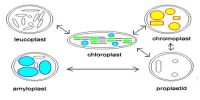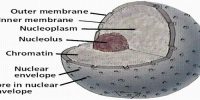The granular, transparent and homogeneous liquid substance present in the nucleus is known as nucleoplasm. It is the substance of a cell nucleus, especially that not forming part of a nucleolus. It is a type of protoplasm that is composed of a thick fluid and constitutes chromatin fibers made up of DNA. It is found inside the nucleus and resembles cytoplasm is some aspects. It is composed mostly of water, nucleoplasm also has an array of complex components.
Structure: The nucleoplasm includes nucleoprotein, nucleic acid, enzyme and mineral salts, etc. Its chemical structure is complicated. The nucleus of most cells contains a substance that suspends structures inside the nuclear membrane. Just like the cytoplasm found inside a cell, the nucleus contains a nucleoplasm. It is completely enclosed within the nuclear membrane or nuclear envelope. It is a highly gelatinous, sticky liquid that supports the chromosomes and nucleoli. This fluid contains primarily water, dissolved ions, and a complex mixture of molecules.

Function:
The main function of the nucleoplasm is to serve as a suspension substance for the organelles inside the nucleus. It plays an important role in the transportation of materials that are vital to cell metabolism and function.
(i) It contains different organelles of the nucleus
(ii) It regulates the physiological activities of the nucleus
(iii) It helps in forming the ribonucleic acid (R N A) and De-oxyribo nucleic acid (D N A).
(iv) It helps to maintain the shape and structure of the nucleus.
(v) It is a highly gelatinous, sticky liquid that supports the chromosomes and nucleoli.
Other functions of nucleoplasm consist of the continuance of nuclear shape and structure, and the transportation of ions, molecules, and other substances vital to cell metabolism and function.
Components of Nucleoplasm
The different components of nucleoplasm include:
- Nucleolus – It is the largest organelle in the nucleus and the organisms will not be able to survive without the nucleolus.
- Nucleotides – They are the building blocks of DNA and RNA. All the nucleotides consist of a base, a phosphate group, and deoxyribose sugar.
- Chromatin – It prevents the entangling of the strings during DNA folding and improves the efficiency of replication.
- Nuclear Matrix – It helps in organizing the genetic material of the cells.
- Enzymes – DNA polymerase is the most important enzyme found in the nucleoplasm. Other enzymes present in the nucleoplasm include hexokinase, P-fructokinase, and 6-P-gluconic dehydrogenase.














